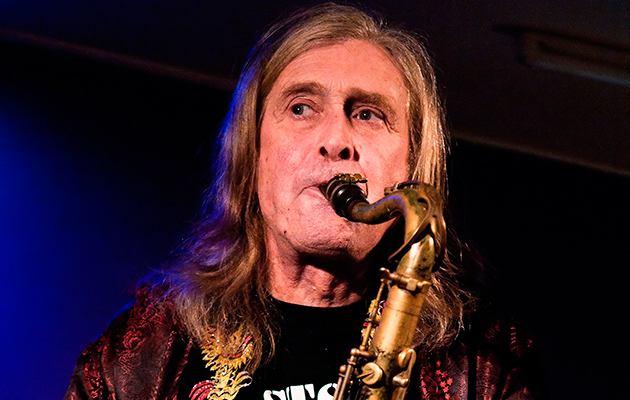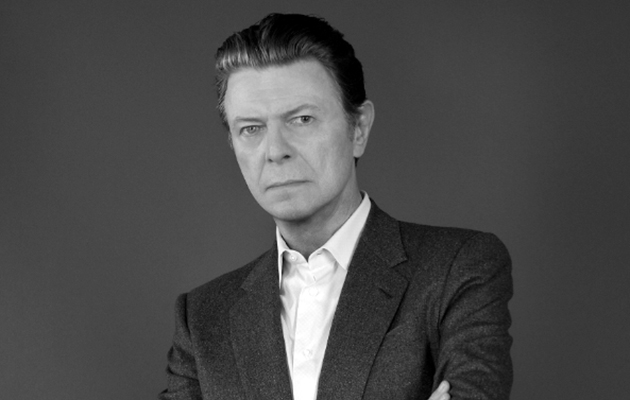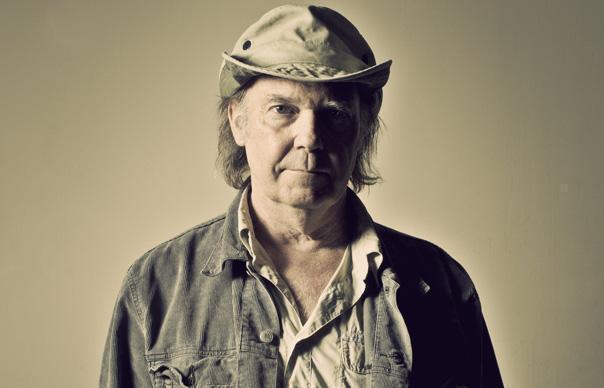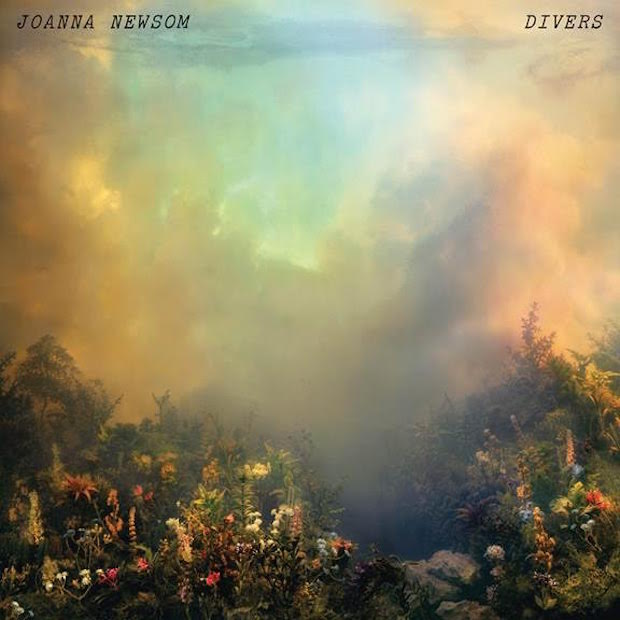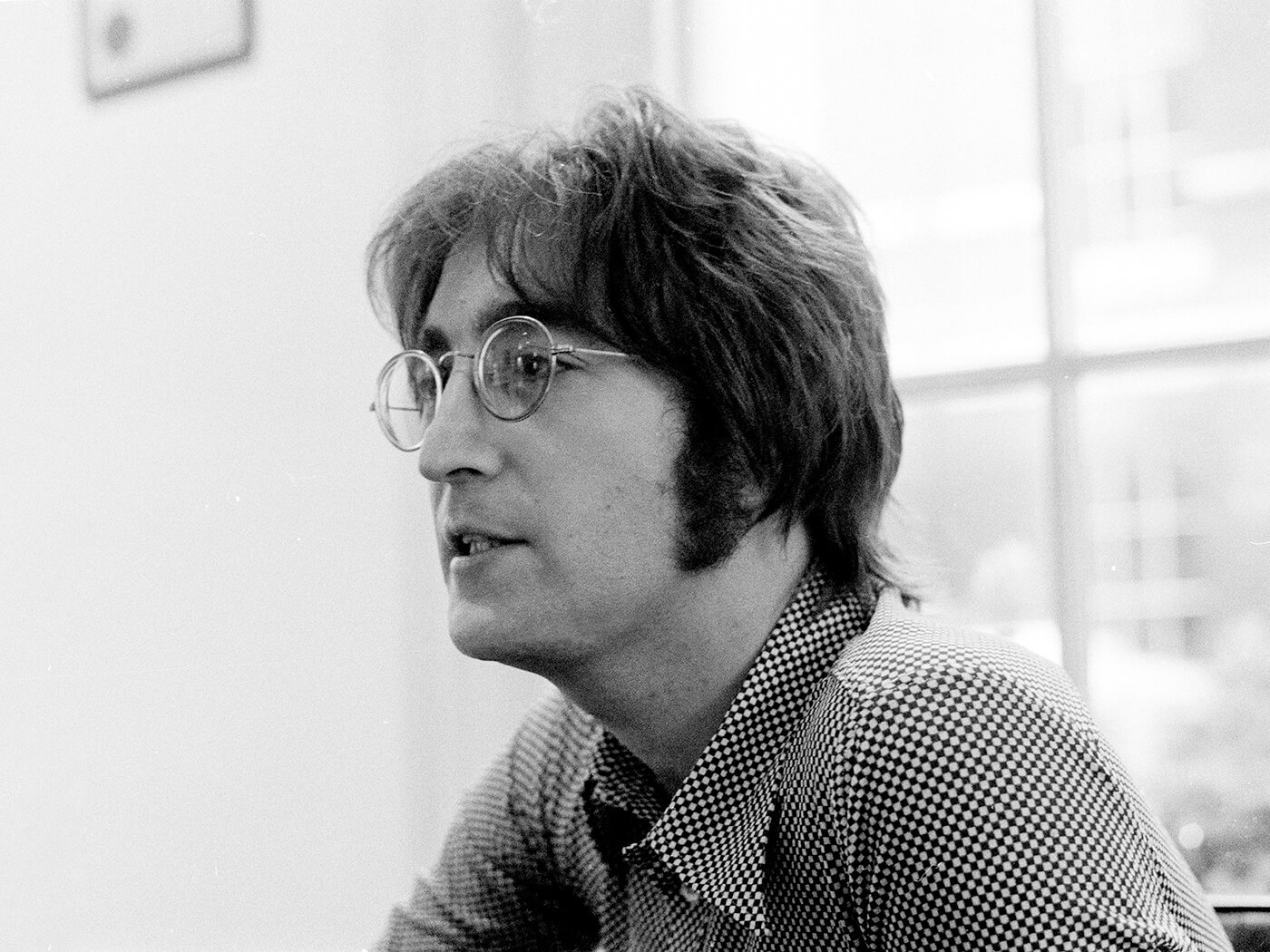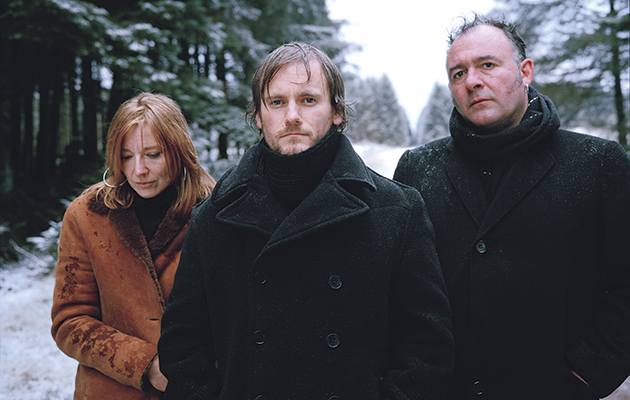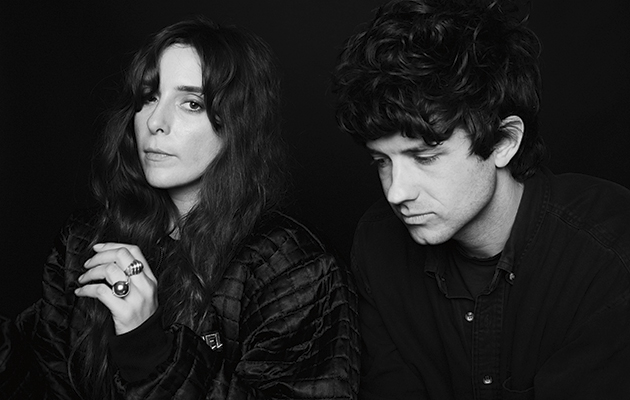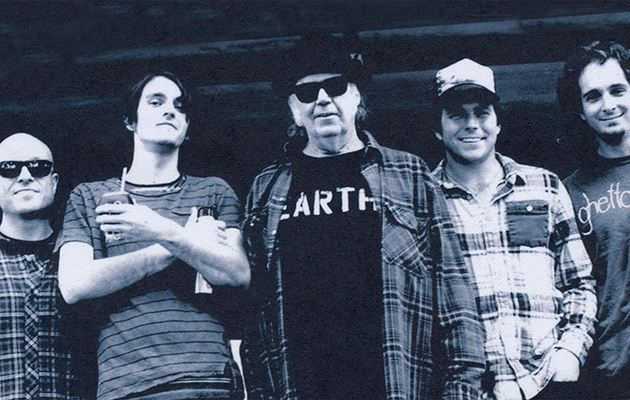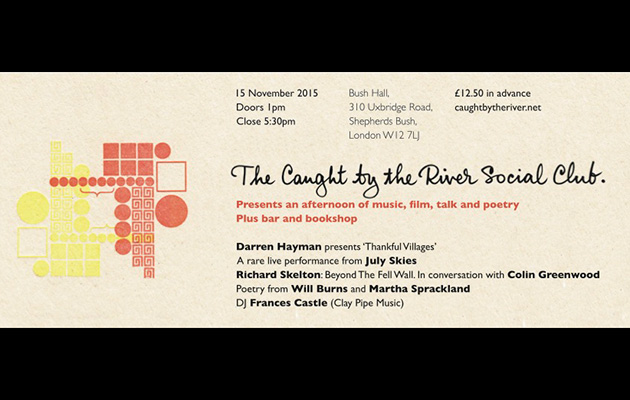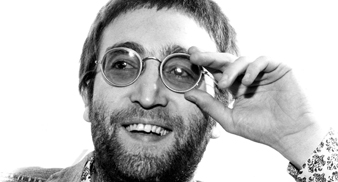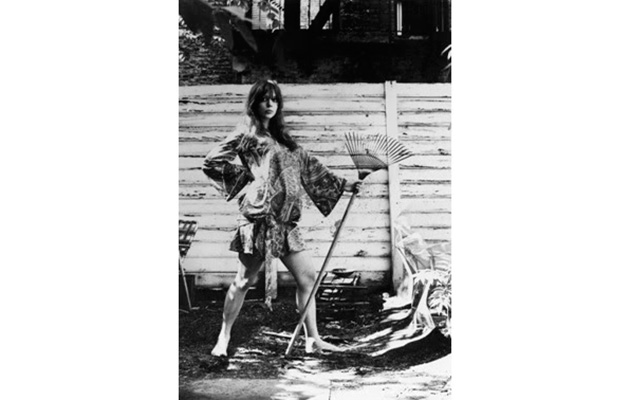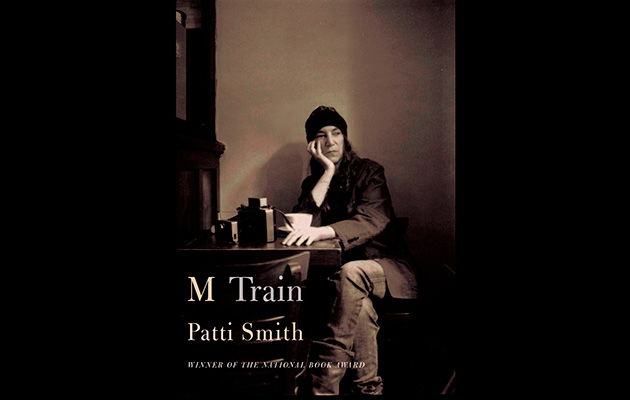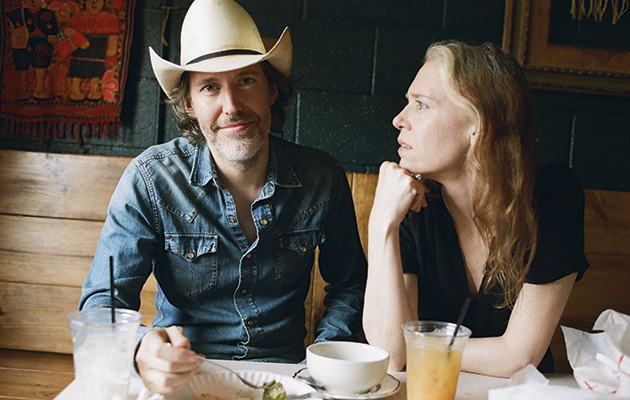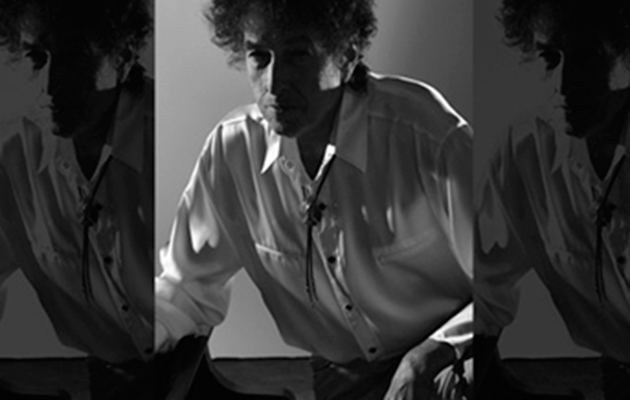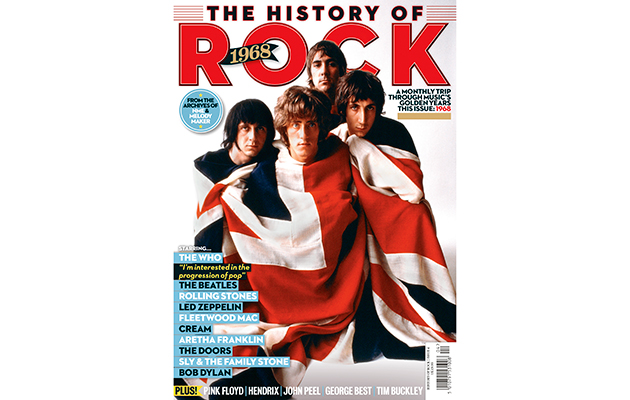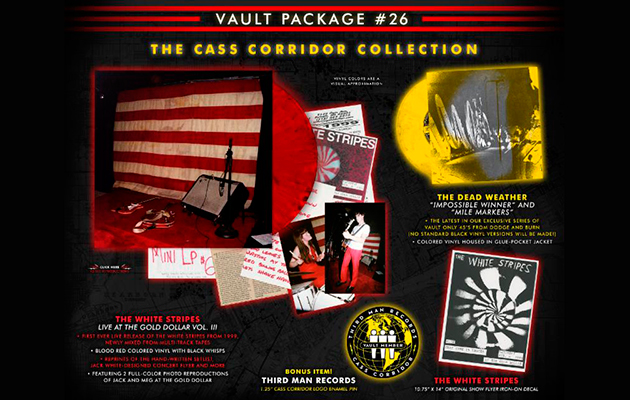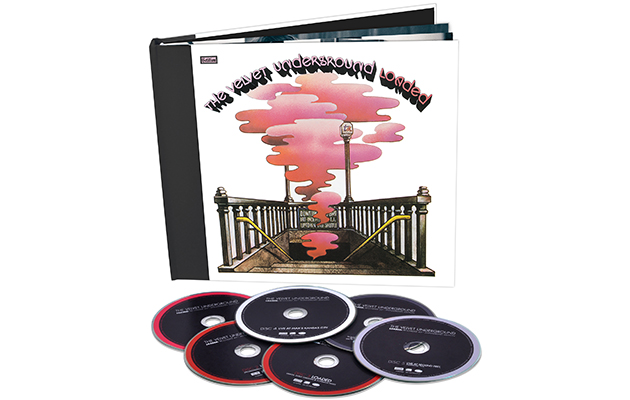Originally printed in Uncut’s September 2003 issue (Take 76), Yoko Ono guides Uncut through an extraordinarily detailed account of her time with John Lennon. From acid and the avant-garde, bed-ins, heroin, the end of The Beatles and the Lost Weekend through to their last tranquil years together – Yoko tells all! Words: Carol Clerk.
Uncut’s Deluxe Ultimate Music Guide to John Lennon is out now – purchase a copy by clicking here
______________________________
It’s the summer of 1969, and John and Yoko are in bed in room 1742 at the Queen Elizabeth Hotel, Montreal. They are in their “Year of Peace”, this is their second and most famous bed-in, and an abusive visitor has confronted them. Right-wing cartoonist Al Capp is apparently trying to goad John into some act of violence that will undermine the couple’s reputation as peace campaigners, frequently addressing Yoko as Madame Nhu – the widely reviled “Dragon Lady Of South Vietnam”.
The smirking Capp insults the Lennons’ efforts to quell the riots erupting at a continuing demonstration in People’s Park, San Francisco, by protesters wanting to save the land from development by Berkeley University. With one person so far shot dead, many injured and thousands arrested, John and Yoko have been talking to the participants by phone and live radio every day, urging calm.
“They started throwing rocks at cops just a couple of days ago,” sneers Capp. “You’d better talk to them a little more.”
“Well, no-one got shot this time, did they?” retorts John.
But Capp persists: “You people have a home in London. Are you permitting people to come in and defecate on the rugs, smash the furniture and beat you up?”
“We don’t agree with violence in that form or any other form,” raps Lennon.
“Why do you want them to do it at Berkeley?” continues Capp.
John’s eyes focus angrily on his detractor. He starts shouting. “We don’t want them to do it at Berkeley! We are telling them to protest some other way! If they’d stayed in bed at Berkeley, they wouldn’t have got killed!”
Yoko attempts a conversation with Capp: “I’d like to ask you what you said about Joan Baez…”
He cuts her dead with a patronising chuckle and remarks to John: “I can see why you want peace… God knows, you can’t have very much, from my own observation, but anyway…”
By this time, John would clearly love to knock him out, but instead endures another flurry of insults before an outraged Derek Taylor, The Beatles’ publicist, asks Capp to leave the room. John intercedes on his behalf, mellowing, chuckling that, “We asked him here.”
John and Yoko: unpredictable, inseparable, crusading, controversial, confrontational, naïve, spontaneous, optimistic, well-meaning, misunderstood – and, to some, downright annoying.
But not to Toronto rabbi Abraham Feinberg, a vocal supporter of their peace effort.
He declares: “The love that the two of them have for each other extends itself to all humanity. It really does.”
——
Some 34 years later, Yoko Ono is sitting in a hotel suite on the edge of the Grand Canal in Venice, sipping chilled water and telling Uncut about that love; about being half of the most famous couple in rock history. Why has their snapshot of togetherness endured through the years?
“Because it was genuine,” says Yoko. “Truth hurts some people – there was a lot of chip-chip and trying to make it sound like it was really something that didn’t happen.
“Maybe in history, a lot of beautiful miracles that happened have been chipped so much that you don’t know about it. It’s the loss of the world to not know that miracles could happen. That was one of the miracles to me. It definitely was a magical thing that happened in my life.”
Yoko is 70, and she recently enjoyed her first No 1 single, with the remixed “Walking On Thin Ice” having topped the Billboard dance chart [May 2003 – see panel, p138]. She approached the milestone birthday on February 18 wondering whether she should keep a low profile, knowing that someone would inevitably work out the dates, or make a stand and announce it. Characteristically, she chose the latter – and when the hit single came along only a couple of months after she blew out the candles, she was suddenly happy to celebrate her age and see it as a reassurance to others.
“Some people immediately feel like, ‘How dare she? Oh, now, well, she must be doing something, some trick there…’ But the majority of people feel really good because they now think that when they’re 70, they don’t have to worry about it.
“I think that’s really good, but also with John and I just getting together – it could happen to anybody. It was just a man and a woman getting together. As long as you know it could happen. It does happen.”
Has the idea of ‘John and Yoko’ become idealised over the years?
“We were just real people, we had our arguments and all that as well. Two very headstrong people. I think that we expressed it differently. It’s like yin and yang. He was like very explosive, and I’m the one who’s, like, ‘Take it in’. It doesn’t mean being submissive. Take it in, and it comes out as songs.”
Yoko is not your average pensioner. She has recently thrown herself into a new life of late nights and live performances in dance clubs around the world. She has had no cosmetic surgery, but looks like a woman in her fifties – trim, energetic, her short, dark hair glowing with a reddish hue and her black top, with its colourful, butterfly patterns, plunging in a V at the front to reveal a daring cleavage.
Yoko is in Venice for the Biennale festival of contemporary art, where she is exhibiting. It’s early in the morning, it’s already baking hot, but Yoko is, as usual, welcoming and direct. She is witty, good-humoured and revealing as she skips through what her husband once called their “scrapbook of madness”.
Yoko was living in a flat at 25 Hanover Gate Mansions, near London’s Regent’s Park, with her second husband Tony Cox and their daughter Kyoko. John was stretching out in the splendid surroundings of Kenwood, a palatial, mock-Tudor house in Weybridge, Surrey, with his wife Cynthia and their son Julian. Months had passed since the legendary first meeting of John and Yoko at the Indica Gallery in November 1966. Occasionally, they had bumped into each other at art openings, but apart from a vague mutual interest, there was nothing remarkable between them.
Despite the popular theory that Yoko was frantically inventing schemes to snare the wealthy Beatle, she was struggling with problems in her marriage and also working hard to establish her career in the UK. Arriving in London in September 1966 to perform at the ‘Destruction In Art Symposium’, Yoko was already respected as an avant-garde artist and performer in New York, where she was allied to the Fluxus movement. She had a trained musical background, and had recently been involved in the improvisational music favoured by her peer group. She had also compiled a book of conceptual and instructional pieces called Grapefruit, and printed up a limited edition.
Yoko distributed copies to a number of influential people during 1966-’67. And John Lennon was one of the recipients. This has since been interpreted as one of various ruses on Yoko’s part to enchant Lennon.
She retorts: “There was a myth that I sent Grapefruit to him… how I wanted to trap him. It was a printed, published book. I had an orange carton of them, a lot of it. I would be giving it to critics. It was that sort of thing. He wasn’t the only one who got it.”
However, Lennon was intrigued – and would later be clearly inspired – by this book with its instructions to “imagine” various things. Keeping it by his bedside, he found it by turns inspiring and exasperating.
“Finally,” says Yoko, “there was a call from him that he’d like me to come to Kenwood. And a car was sent for me, and I went and I was thinking, ‘What is this about?’ He said he’d read Grapefruit, and he wanted to know whether he can get this Light House on the sales list in Grapefruit.”
Appearing under “Architectural Works” in the book’s spoof merchandising list, Light House is described as “a house constructed of light from prisms, which exists in accordance with the changes of the day”.
“And he wanted to build that in his garden,” smiles Yoko. “I said, ‘It’s very sweet… but it’s conceptual.’’’ She pauses, laughs affectionately.
And after that: “Many things happened.”
It was an unconventional courtship.
“There were times when he would call me,” says Yoko. “My guess was that he was in the studio where they [The Beatles] had to wait for the engineer to prepare the tapes or whatever. And there was times when he was upstairs on the third floor at Kenwood. He had this kind of a studio, many tape recorders and all that, and he’d be there, probably, just being alone with the tapes. That’s the kind of time that it seemed like he called. I was always wondering why he called me. There was many people who used to call and just chat. He wasn’t chatty – ‘Hi’. Then silence. I wasn’t chatty either. There was a lot of silences in the phonecall.”
In 1967, Yoko talked to John about a show – ‘Half-A-Wind’ – that she wanted to put on at the Lisson Gallery in Bell Street, Marylebone. It went ahead in October and November, and it included her famous “Half-A-Room” – where the furniture and objects are neatly sliced in half and painted white. The other halves are “contained” in 15 empty, labelled bottles of varying sizes. The show was billed as “Yoko And Me”, the “me” referring to Lennon, who did not attend because he was “too uptight” but nevertheless funded it.
Yoko: “I didn’t have the money to do it. I needed a patron to put up some money, and he [John] said he would like to do it. I explained it all, and I’m looking at him and I thought, ‘Here’s a guy who’s an artist himself, and a very good one,’ and by then, I really felt it was good.”
Is this the source of the stories that you were chasing John for his money and profile – as a benefactor for your artwork?
“It’s possible. I don’t connect in that way. In America too, when I was doing some projects, Tony, my then-husband, would go and raise money and then he would say, ‘Oh, so-and-so is putting up the money, so we have to have dinner with him and thank him.’ I’d come out at the end – the artist! – and say, ‘Thank you.’ Tony did the work, kind of thing. With Lisson Gallery, the reason why I went to John – because he invited me to talk about it and everything – it’s because Tony and I were not really getting along too well any more, and so I thought, ‘Now I have to do it myself.’ And it was a bit embarrassing for the artist herself to do it.”
How did you feel about asking John for the backing?
“I’m approaching him as a patron to raise money or something. He wanted to do it. He was taking the position of somebody with money and I felt terrible about that. I said, ‘Well, why don’t you put a piece in there, too?’ It’s not the kind of thing I’d ever say to anybody. I’m an artist myself who likes to fill the room with my works. He immediately said, and this was funny, cos I was putting together “Half-A-Room” – he said, without even missing a beat, ‘Why don’t you put the other half in the bottles?’ I just thought that was an incredible idea, and I just stood there. It was beautiful. And he was very pleased.”
He understood your work.
“Of course. It’s not like he understood it – he was on exactly the same wavelength. That’s the kind of thing that he would do if he had a chance.”
Did it surprise you that someone from such a different environment, a pop superstar, could be on the same wavelength?
“What I was amazed about was not so much finding somebody from a different environment – I was just amazed that he was so different from other guys. Because this society is like a male society, they tend to be very conservative. He just wasn’t. Or shall we say, I didn’t see that side of him at all at that point.”
Was that the moment that it all really started?
“What happened was… and it’s all mixed up, in a way, in people’s minds… I never bothered to talk about it. But there was a time in London – time-wise, the Lisson show was on already – when John made a kind of decisive move to me, and I didn’t think that I should take it. I didn’t, in fact. After that, there was immediately an invitation I got from the Belgian Knokke Film Festival. They invited me to show my Film No. 4 – the butt film [aka Bottoms].
“So I went to the Knokke Film Festival and my work was shown. Then all the artists were going back home and they were saying, ‘Are you coming to London?’ And a very famous artist called Jean-Jacques Lebel – he and his group said, ‘We’re going to Paris, do you want to go?’ I went to Paris instead of going back to London. I thought, ‘I will never go back.’ Paris was great fun. I kept saying, ‘I’m not going to go back to London.’ I had this feeling about John – our feelings were getting too close to danger. I thought, ‘Totally, that’s it.’
“As an animal instinct, I must have known that there was something really seriously wrong there, you know. The kind of incredible attack I got from the whole world – of course, I never knew that that would happen. I knew that we were kind of hot about each other by then. In any situation, it was so easy to run. It was always that. Because it’s my instinct to protect myself, I suppose. I could be sort of destroyed.”
What made you change your mind about coming back to London?
“So then, he went to India. I was in Paris. It was like that. And fate would have it that [American modern-jazz saxophonist] Ornette Coleman came to a show I did in Paris. It was music and performance art. He said he’s going to go to Albert Hall to do a concert [on February 29, 1968], and would I come and perform there.”
That’s an honour…
“You don’t know what I was like. I said, ‘If you’re going to do my composition, I’ll come with you.’ He said, ‘OK, sure.’ I didn’t want to be a vocalist in somebody else’s composition. That was not my style. And then when I went back, well, I went into my apartment – and my then-husband Tony was staying somewhere else – and when I opened the door, there were piles of letters from John in India. [Hands on heart] It hit me.”
——–
Yoko had also been writing to Lennon, who returned from Rishikesh, where he had been studying transcendental meditation with the Maharishi Mahesh Yogi, earlier than expected. It was spring, and John and Yoko were only a taxi ride away from the love affair that would shock the nation – and The Beatles.
There have been stories that both before and after India, Yoko had pursued John relentlessly, arriving at his house unannounced and bombarding him with phonecalls. Yoko has only recently started to address these allegations, replying firmly that it was Lennon who made the running. She tells Uncut that on each and every occasion she visited John at Kenwood, it was at his invitation.
What happened when John came back from India?
“I was in London because of this concert that I did with Ornette Coleman. So one day John called me and said, ‘OK, shall we meet?’ but by then we knew how we were feeling, totally, through the letters. It was at night. He said, ‘Are you coming?’ I said, ‘OK.’ He didn’t have the driver that night, and so he said, ‘Take a taxi.’ I went there, and he was waiting with the change to pay the taxi. And that night we made it.”
You also recorded the music that became Unfinished Music No 1: Two Virgins…
“Oh yes, of course. John said, ‘We can do two things.’ He was sitting in the living room. ‘One is just sit here and chat, or go up and make music.’ He didn’t mean ‘make music’ in a ‘funny’ way. He really meant make music. [Giggles] I said, ‘Let’s make music.’ I’m not very good at small talk, sitting and chatting. That sounded boring to me. It sounds more exciting to make music. We went in the attic and we made music, and that was Two Virgins.”
Cynthia was abroad at the time. One famous story says that when she came home, she was shocked to find you and John together, and that you were wearing her dressing gown or kimono. Is any of this true?
“That’s a dramatic story. I’m not saying it came from Cynthia. I don’t know who… maybe some writer embellished it or something like that. First of all, the driver and Lil, who was Julian’s nanny – they were reporting to Cynthia all the time. She knew. It was an open thing in a way. She said, ‘I don’t want to come back now.’ The first time that she came, she was with Pattie Boyd’s sister [Jenny] and [Magic] Alex [Mardas] and there was another person. So Cynthia and Alex and Pattie Boyd’s sister and whoever the guy was said they were gonna visit, and they came in from the garden side.
“I immediately tried to sit a little bit further from John, and John said, ‘No, don’t worry about that, it’s OK.’ He just grabbed my hand and we were sitting together, kind of thing. He wanted it that way. I don’t know why. He wasn’t like, ‘My wife is coming, I have to hide the situation.’ Totally not like that. They stayed a while to say ‘hi’, and left from the front door – not in a huff. There was an underlying tension, but we were all civil, like the flower children we were.”
So you weren’t wearing Cynthia’s clothes?
“No, I wasn’t wearing… I was always wearing a kind of Indian shirt, one of those loose, cotton pullovers, and the Indian big pants. And their visit happened in May, immediately after John and I started to live together.”
Things obviously moved very quickly after that first night together. Was it a hard decision to break away from your past lives?
“It wasn’t like that. It was like I was ready to be independent from my marriage and I thought, well, OK then, I would probably live in a loft by myself or something like that. John didn’t like that idea. And so we came together that first time and we finally got together in May – we started living together.”
———-
In his memorable Rolling Stone interview with Jann S Wenner, later published in book form as Lennon Remembers, John explained his growing attraction to Yoko, who was seven years his senior. The imagination and mischief at play in her exhibitions had struck him. But it was when he kept dipping into Grapefruit, and when she sent him a series of instructional cards as part of her ‘Dance Event’ before the Indian trip, that he really began to react to Yoko. He was fascinated by this diminutive woman whose work annoyed and uplifted him in equal measure. He wanted her to come to Rishikesh, kidding himself it was because of the ‘artistic’ stimulus she would bring, but he couldn’t see how to square it with Cynthia, and bottled out.
For John as well as Yoko, the moment of truth came on the night at Kenwood when they dropped acid, recorded Two Virgins and made love at dawn. At the time, he said, he knew “very few” people with whom he could share his interest in experimental, electronic and comedic music. In an interview only two days before he died, he told Radio 1’s Andy Peebles: “I realised somebody else was as kind of barmy as me, a wife with sort of freaky sounds and could equally enjoy non-dance music that was… they call it avant-garde, but whatever it is, you know.”
Years earlier, in the first flush of the affair, he had this to say: “I’d never known love like this before, and it hit me so hard that I had to halt my marriage to Cyn. And I don’t think that was a reckless decision, because I felt very deeply about it and all the implications that would be involved… My marriage to Cyn was not unhappy. But it was just a normal marital state where nothing happened and which we continued to sustain. You sustain it until you meet somebody who suddenly sets you alight.
“With Yoko, I really knew love for the first time. Our attraction was a mental one, but it happened physically, too. Both are essential in the union…”
From now on, John and Yoko were joined at the hip, and Cynthia resignedly accepted it. She later declared: “I knew at the time there was nothing I could do to stop what was happening. He was hell-bent on something. And it happened to end up he was hell-bent on Yoko. “What he was looking for was a woman and a man combined. Someone he could call a pal, someone who was a woman, someone who encompassed everything in his life.”
Cynthia could not be that person: “I did not want to go down the road that John was going… which was the road of ‘enlightenment’ as far as drugs were concerned. John was in a more trapped situation than I was, trapped in his own mind and in the Beatles’ situation and the pressure of the music and the pop world. And I think he’d had enough and he wanted to escape that. I had nothing to escape. I wasn’t looking for anything else.”
It’s also been proposed that John was looking for a mother figure, having lost his own mother, Julia, twice – once when she gave the five-year-old over to his Aunt Mimi, who raised him, and then when she was knocked down and killed in 1958. John’s pet name for Yoko was Mother.
The other Beatles were perplexed, unsettled by Yoko’s constant presence, later becoming resentful and hostile.
Not only was she invading the sacrosanct territory of their ‘boys club’, but she was distracting John from them and from the band. As Yoko introduced Lennon to new, leftfield interests that they didn’t share, and as his outlook broadened, so they saw his personality ‘change’. John later confirmed: “That old gang of mine was over the moment I met her.”
The Beatles regrouped in the studio at the end of May 1968 to start work on the White Album. As the sessions continued through the summer and autumn, their intolerance of Yoko increased, especially when she felt inclined to contribute her unorthodox vocals to the recordings, or dared to venture a critical opinion – which she felt justified in doing, given her musical training. (“Revolution 9” was almost entirely the work of John and Yoko.)
However, it was the way in which the couple isolated themselves from the others that caused the greatest alarm. Yoko has since explained that John wanted her by his side in Abbey Road, and later ordered a bed to be brought into the studio so she could be there even when she was ill. She has also revealed that he was jealous of any conversations she had with the other Beatles. Therefore, she kept her distance. As John described it, “Suddenly, we were together all the time in a corner, mumbling and giggling… and my attention completely went off them.”
He also said, “Everybody seemed to be paranoid except for us two who were in the glow of love… all this madness is going on around us because we just happened to want to be together all the time.”
George Harrison said in the Anthology that he was bothered by having a “stranger” in their midst and also by a “weird vibe” emanating from John and Yoko. He regarded her as a “wedge”, driving herself deeply between Lennon and his bandmates. Paul McCartney remembered a feeling that Yoko had “encroached on the framework that we’d had going for us”, and that it was “fairly offputting”. Ringo reported that the Beatles had been “very possessive of each other”, and that Yoko’s presence created tension.
Press officer Derek Taylor commented: “Yoko had taken the place of everybody in John’s life. Since they had met, she was his life and he was hers and they were very co-dependent people. They had no life outside each other.”
John put it like this: “Being with Yoko makes me free… We are two halves, and together we’re a whole.” He was still bitterly angry about The Beatles’ treatment of her when he talked to Wenner in 1970.
“They despised her,” he raged. “They insulted her and they still do… They all sat there with their fucking wives and judged us… Ringo was all right. So was Maureen [Starkey]. But the other two really gave it to us. I’ll never forgive them.”
He later became more conciliatory towards Paul and, certainly, George. And Yoko, today, chooses her words carefully when she talks to Uncut about the other Beatles.
“Actually, they were very civilised people, of course, and they weren’t really nasty to me. I noticed a few things on a very delicate level. When they were recording and I was there, I suppose it wasn’t something that they really wanted but, at the same time, John was there, so they weren’t going to make a fuss. I don’t nit-pick on it, because it wasn’t so bad. But, of course, there were moments… but there were moments between them all.”
Ringo, for one, left the band during this period because he felt like “an outsider”. George had already “had enough” of The Beatles, complaining that he was being treated as an inferior, especially by Paul, and was looking to a future involving Indian music, culture, philosophy and religion.
———–
“Yoko taught me about women,” said Lennon. He also asserted that, “She’s the teacher and I’m the pupil.”
Widely regarded as something of a misogynist in his earlier years, with allegations of violence, the tough and cynical Lennon was perhaps an unlikely candidate for a new life of peace, love, flowers and feminism. Yoko has since disclosed that he was never violent towards her.
Do you think you brought out the more compassionate side of John?
Yoko: “Most people think that he was just a wild thing. He had a very considerate side. And wise. A lot of things were brought out from him around that time. It’s not necessarily just being with me, but I think it had a lot to do with the fact that he was repressing all that before the opportunity was given to him to just be himself.”
Did he bring out anything new in you?
“It’s not so much bringing out in me. One is the fact that I learnt a great deal from entering his world, because it’s a world that I never even thought existed; the rock world. And also, he was extremely wise about how to deal with the press. Paul is a better dealer with the press, I’m sure. John was not so much of a person to manipulate the press at all. I came from a tradition of, ‘Not concerned about the press,’ kind of ivory tower and a bit of snobbery and all that. On the stage [during past performance-art events], when the curtain’s up, you see me with my back against the audience. That was the attitude. And so everybody walked out of your concert – it’s a successful concert! A classic avant-garde idea.
“So when we did the ‘You Are Here’ show, John’s show [his first complete art exhibition, at the Robert Fraser Gallery in Duke St, London, on July 1, 1968], we came out of the car and there were tons of reporters there, and the photographers, and my first instinct was, ‘Let’s immediately rush into the back room.’ He said, ‘They are waiting and we have to accommodate [them].’ We stood and let them take the photos. I thought, ‘Oh, that’s what you do.’ To that extent, I was totally naïve.”
From the beginning, you and John set out to celebrate your relationship in records, film, on TV and in the press. Why was this important?
“John was more gung-ho about it, and I thought that was good in a way – like now that I’m announcing that I’m 70 – to just clarify things and let people know that it’s fine, it’s OK. Likewise, when John and I got together, he wanted to share with the world for many reasons – and the reasons probably were similar to mine. One, out of love, of course, but also, two, to show that man and woman can stand together, and also we were from different parts of the world.”
So it was a stand against sexism and racism. Yet these were the very things that you experienced from the public after stepping out with John. How disappointing was that?
“It [racism] was always there, and also sexism was obviously always there. Most women had to cope with it, I suppose. They’re still coping. Racism, too, is still there. You can’t speak out enough about it. The more you speak about it and mix together and everything, people will start to think that equality is a good thing.”
———–
Lennon said of the controversial Two Virgins sleeve photograph, featuring himself and Yoko in full-frontal nudity: “We used the straightest, most unflattering picture just to show that we were human” – a recurring theme throughout their autobiographical ventures. He also explained: “We felt like two virgins because we were in love, just met, and we were trying to make something.”
The picture stunned not only the media but everyone in The Beatles’ organisation – including Ringo, who described it as “the mind-blower”. The album should have been Apple’s first release, but it was held up for months over the refusal by EMI in the UK and Capitol in America to handle it, and it was finally distributed to the shops in brown paper bags through two small companies: Track (Britain) and Tetragrammaton (US). Some 30,000 copies were confiscated in New Jersey, and many shops refused to stock it.
Yet John and Yoko would go further, filming themselves apparently making love in footage that would be released on video.
Was this an inhibiting or liberating experience?
Yoko: “We didn’t do it really porno.”
It’s more sensual, romantic.
“We thought so, too. It was a romantic version of Two Virgins. It was a little bit gritty. Saying to the world that it’s all right to look as you are; I was four months’ pregnant. With making that, making love is not confronting the world – it’s a different kind of message, I think, and that’s what we wanted to convey.”
You got married on March 20, 1969. What is your most vivid memory of that day?
“It was just very sweet. It was in Gibraltar and all that, and it was exactly the way we wanted – casual enough, but also romantic, and it expresses a clothing that’s casual. That’s something that we loved. That’s how the whole thing was – casual but loving.”
During the honeymoon, you held a week-long bed-in for peace in the Amsterdam Hilton, and there were similar events in Canada. How strongly did you feel that together you could help to change the world, even a little bit, and did you?
“We thought it’s good to do it that way, with a sense of humour. It was a laugh, in a way. Some people took us seriously and were attacking us. But, actually, it was a big clown thing. And through clowning, we communicated the idea of world peace being very important… We were inspired by what was being done at the time, which was very serious. People were distributing pamphlets about world peace, but nobody wanted to know or to read, and especially the young didn’t want to do anything about it. We wanted to express in the way that our constituents would understand or appreciate.”
The media had a field day. John and Yoko invited ridicule, and got it in bucketloads. John admired the events that Yoko had staged for peace before they became a couple – memorably wrapping one of the Trafalgar Square lions in cloth – and he remained interested in the concept of “extreme concealment”, later dubbed “bagism”.
In their first public event, in June 1968, John and Yoko planted acorns for peace at Coventry Cathedral, and soon afterwards attended the London premiere of Victor Spinetti’s The John Lennon Play: In His Own Write. They were besieged by journalists: “Where’s your wife, Mr Lennon?” Overnight, Yoko Ono became Public Enemy Number One.
Upset but undeterred, John and Yoko continued their crusades. After the Amsterdam bed-in, they held a press conference in Vienna in a white bag and, in April 1969, sent acorns to leaders around the world. The Canadian bed-ins happened over May and June in Toronto and Montreal where, during a week in bed, they wrote and recorded “Give Peace A Chance” with everyone who happened to be visiting.
This coincided with the UK release of a new Beatles single – “The Ballad Of John And Yoko”. Only John and Paul played on the track, with McCartney adding drums, bass, piano and percussion to John’s account of his wedding and honeymoon.
Ironically, this was the follow-up single to “Get Back”, which John had interpreted as an attack on Yoko by McCartney.
Their private lives had also been making headlines. John and Yoko were living in a flat owned by Ringo at 34 Montagu Square, Marylebone when, on October 18, 1968, they were busted by the drug squad. The team found a quantity of marijuana which John and Yoko later claimed was planted – although John did also wonder if it could have been an old, forgotten stash.
Only days afterwards, Yoko announced she was pregnant. But early in November, she was rushed into Queen Charlotte’s Hospital amid fears of a miscarriage. John camped at her bedside and made a series of recordings which turned into the Life With The Lions album, in line with his new philosophy that songs should be like newspapers.
On November 21, Yoko miscarried the baby – John Ono Lennon II, who was properly buried in a secret ceremony.
Attending Marylebone Magistrates Court on November 28, John pleaded guilty to possession of cannabis, keeping Yoko out of things for fear she would be deported. His solicitor suggested that the stress arising from the bust had contributed to Yoko’s miscarriage. Lennon was fined £150 and told to pay costs of 20 guineas (£21) – and the conviction would lead to serious problems. It inhibited his ability to travel, and it would be seized upon by the Nixon administration as an excuse to deport him from America.
The US authorities disliked the couple anyway. In January 1969, the FBI opened a file on John because of the “subversive” nature of Two Virgins. His newly acquired police record meant the Lennons had to stage their bed-ins in Canada rather than America, although they came to like the Dominion, which was generally supportive of their peace initiatives while affording access to the US media.
On the domestic front, John legally changed his name to John Ono Lennon in a ceremony on the roof of the Apple building at 3 Savile Row on April 22, 1969, stating: “Yoko changed her name for me. I’ve changed mine for her. One for both, both for each other.” The next month saw them move into Tittenhurst Park, a Georgian mansion with 70 acres of land at Sunningdale, near Ascot in Berkshire. By now, John and Yoko had discovered heroin.
John had enjoyed a succession of drugs, beginning with alcohol. In the early years, The Beatles had gobbled Preludin amphetamine tablets – “Prellies”. Abandoning pills and alcohol in favour of pot at the time of Help!, John soon graduated to acid, commenting that, “I must have had a thousand trips. I used to just eat it all the time.”
Talking to Jann Wenner about smack, Lennon remembered: “We sniffed a little when we were in real pain… People were giving us such a hard time. And I’ve had so much shit thrown at me and especially at Yoko… We took H because of what The Beatles and their pals were doing to us.”
In a 1997 conversation with Uncut, Yoko expanded: “We both felt it was very effective in the sense of slowing down our minds. If you get an upper, because we’re both very up people anyway, we would just go crazy with this. So we couldn’t take an upper, you know. We took a downer.”
She revealed that they experienced several periods of heroin use – and never found a decent dealer. However, it was their withdrawal from that first encounter with smack that gave rise to the chilling “Cold Turkey”, released in October 1969 by the Plastic Ono Band – a ‘conceptual’ group featuring John, Yoko, and any musicians who happened to join them.
Yet their withdrawal from the heroin substitute methadone was even more horrific.
Yoko said: “It was the wrong information that somebody gave us that there was a new drug called methadone and that gives you the same high as smack, but you don’t get hooked on it, and so, ‘Whoopee’, you know, and at that time we were totally dry. So most people take methadone because they want to withdraw from smack and we weren’t taking smack, we weren’t taking anything, so it was the silliest thing to do. So we got hooked on methadone…”
Coming off methadone was “the hardest thing that I’ve ever done,” Yoko added. “And I’m sure that’s true for John too… After that, we couldn’t get hooked on anything.”
———–
Lennon was conducting two careers, one with The Beatles and the other with Yoko. He was thrilled and excited by her unconventional approach to music, art, film and protest, and he promoted her work endlessly. She was, he said, “the ultimate trip”.
In November 1968, The Beatles released the White Album, and only a week later, John and Yoko’s long-delayed Two Virgins emerged. At the same time, “Hey Jude” – Paul’s song of reassurance to Julian Lennon over his parents’ split – was selling millions.
In the new year, the Yellow Submarine soundtrack entered the shops, and the Fab Four performed for the last time on the roof at Apple on January 30. John and Yoko carried on with Unfinished Music No. 2: Life With The Lions, released in May 1969 by Zapple – Apple’s new experimental label – and, two months later, with the Plastic Ono Band’s first single, “Give Peace A Chance”.
In August, The Beatles were recording their final album, Abbey Road (although it would be released before Let It Be). At the beginning of 1969, at Paul’s instigation, they had been filmed rehearsing in Twickenham Film Studios and the Abbey Road basement, and the so-called “Get Back” sessions resulted in the Let It Be album and movie. In an atmosphere of apathy, misery and ill-temper, with George storming out and John and Yoko in what seemed like a heroin-spun cocoon that completed their withdrawal from the other Beatles, the group disintegrated in glorious Technicolor.
Lennon, however, was exhilarated by the minimalist, arty films he’d been making with Yoko – 1968’s Smile, Two Virgins and the controversial Rape, where a randomly chosen female was stalked by a cameraman. They would produce a string of equally infamous morsels, including Self Portrait, with Lennon’s private member attempting an erection, Up Your Legs Forever, showing more than 300 pairs of legs, and Fly, in which a fly explored a woman’s naked body. However, 1972’s Imagine was a glossy, mainstream production mostly set in Tittenhurst Park.
John: “I decided that I could no longer artistically get anything out of The Beatles. And here was somebody [Yoko] that could turn me on to a million things.”
Lennon missed playing live, and now he realised he could do that with Yoko, too. In December 1968 they performed at The Rolling Stones’ legendary Rock’n’Roll Circus as The Dirty Macs with Eric Clapton, Keith Richards (on bass) and Jimi Hendrix’s drummer Mitch Mitchell.
Flying out to Toronto the following year for the September 13 “Rock’n’Roll Revival” concert, Lennon told manager Allen Klein on the plane that he had decided to quit The Beatles. He also informed Eric Clapton and Klaus Voorman who, along with drummer Alan White, comprised the latest, makeshift incarnation of the Plastic Ono Band. “Full of junk” and throwing up from that and nerves, Lennon followed on with an amazing performance that featured Yoko in a bag for the majority of the set, emerging only for her own spectacular finale.
Lennon: “The buzz was incredible!”
A week later, at a meeting in London, he told Paul, George and Ringo he was leaving, and agreed to keep it secret for the time being. Their next releases – Abbey Road in September and the “Let It Be” single in March 1970 – went ahead without any fuss.
For John and Yoko, it was business as usual. In November, a couple of weeks after the release of the Wedding Album, John returned his MBE to Buckingham Palace.
They launched their “War Is Over (If You Want It)” poster campaign in December, and in January were again outraging public decency when the police raided an exhibition of John’s “Bag One” lithographs (depicting his honeymoon with Yoko) at a London gallery. The eight confiscated prints were later deemed by a court not to be obscene. Later that month, the Lennons wrote and recorded “Instant Karma” in a day, their first collaboration with producer Phil Spector.
They had issued a statement on New Year’s Eve to declare 1970 “Year 1 AP (After Peace)”: “We believe that the last decade was the end of the old machine crumbling to pieces. And we think we can get it together, with your help. We have great hopes for the new year.”
However, there were no great hopes for The Beatles. Paul’s determination to keep them together felt to the others stifling, dictatorial, with John complaining he treated them like “sidemen” during the “Get Back” sessions. Realising this, McCartney tried to hold his tongue, but both John and George could already see a future away from the band. It looked very attractive.
The Beatles’ finances had been in chaos. They had lost the ownership of many of their songs, and Apple was losing money hand over fist. John, George and Ringo successfully fought for the appointment of American businessman Allen Klein to sort things out – against McCartney’s father-in-law Lee Eastman and his son John. It had been getting nasty.
It would get nastier still in April 1970 when, a month before the release of Let It Be, Paul announced his solo album, McCartney, with the news that he was leaving The Beatles – to the fury of Lennon, who had observed his vow of silence. It would take years in court to disentangle their affairs, McCartney successfully suing the other three to extricate himself from their partnership, which resulted in their assets being frozen.
Beatles fans, naturally, blamed Yoko for the split, and John called them “idiots”. But his loyalty to Yoko, and commitment to their life together, certainly contributed.
Lennon: “I can’t impose far-out films or far-out music on George and Paul if they don’t want to do it. Vice versa. Paul can’t impose on me whatever he likes, especially if there’s no common goal.”
He also explained: “From the day I met her [Yoko], she demanded equal time, equal space, equal rights – I think that’s what kills people like Presley. The king is always killed by his courtiers, not by his enemies. The king is over-fed, over-indulged, anything to keep him tied to his throne – and what Yoko did for me was to liberate me from that situation. And that’s how The Beatles ended. Not because Yoko split The Beatles, but because she showed me what it was to be Elvis Beatle…”
Ringo later commented: “Yoko’s taken a lot of shit, her and Linda, but the Beatles’ break-up wasn’t their fault. It was just that suddenly we were all 30 and married and changed.”
Paul claimed he felt inhibited by Yoko, but was also “jealous” and afraid for the Lennon-McCartney partnership.
John: “I presumed I would just be able to carry on and just bring Yoko into our life, but it seemed that I either had to be married to them or Yoko. I chose Yoko, you know? And I was right.”
He added: “There is no reason on earth why I should be without her. There is nothing more important than our relationship, nothing. And we dig being together all the time. . . I’m not going to sacrifice love, real love, for any fuckin’ whore or any friend, or any business, because in the end you’re alone at night.”
———–
John and Yoko had been travelling. In December 1969 they returned to Toronto, staying with country singer Ronnie Hawkins, from whose home they issued peace messages. They also announced a three-day peace festival for July 1970, although the plans would eventually collapse, with Yoko admitting that, as artists, they were not the world’s best organisers. In Ottawa, they met Canadian Prime Minister Pierre Trudeau. “If all politicians were like Trudeau,” said John, “there would be world peace.”
For the New Year, they flew to Denmark to visit Kyoko, now living with her father, Tony Cox, and his new wife Melinda, near Aalborg. Cox had become religious and disapproving of tobacco, alcohol and drugs. He later reported that John and Yoko “did a lot of symbolic things” – they stubbed cigarettes out in the snow and chopped off their hair.
Finally receiving US visas, they flew to Los Angeles in April 1970 to continue the “Primal Therapy” course they had begun in England with psychotherapist Arthur Janov, together exorcising childhood demons – and learning of their potential for self-destruction.
“We’d be together 24 hours a day… to protect our love,” said John. “We were really beginning to choke each other.”
Yoko added: “Though we were in love desperately… we were possessive and jealous and all that.”
Although they later denounced Janov, they poured his primal screaming techniques into the radical and powerfully intense albums, John Lennon/Plastic Ono Band and Yoko Ono/ Plastic Ono Band, both recorded with Phil Spector and released in December 1970.
With the sessions complete, they flew to New York to work on Up Your Legs Forever and Fly, helped by an Allen Klein employee called May Pang. And then they were off to Japan. In January 1971, John met his in-laws for the first time at their home in Fujisawa, outside Tokyo. Yoko’s mother later commented: “My husband and I found Lennon very nice and gentle.”
Also for family reasons, the Lennons flew to Majorca in April, where Tony Cox was studying meditation with the Maharishi, no less. They had hired private detectives to find Cox, who had disappeared with Kyoko after the Danish visit. The trip ended with John and Yoko being questioned by police about their alleged kidnapping of Kyoko from a playground. Eventually, Kyoko was returned to Cox’s care, and the Lennons were advised to seek a custody order from the authorities in the Virgin Islands, where Yoko and Cox were divorced.
In May, the abduction charges were dropped, and despite a series of court proceedings which saw Cox jailed for refusing to produce the child, Yoko would not see her daughter again for three decades – even though she was granted temporary and then permanent custody. Cox had vanished again with his family, and this time they could not be found.
You were accused of kidnapping your own daughter.
Yoko: “Yeah.”
How did you feel about that?
“Well, I can’t go into it…”
John and Yoko were spending more and more time in America, flying in and out with assistant May Pang. They stayed in the UK for long enough to record and film most of Lennon’s Imagine and Yoko’s Fly, to promote the paperback publication of Yoko’s Grapefruit and to march in a couple of political rallies in London. When they returned to New York in August 1971, it was for good. John sold Tittenhurst Park to Ringo, and never saw England again.
In America, he said: “We want to stay permanently because New York is the centre of the earth and also because we want to find Yoko’s daughter Kyoko.”
They lived at the St Regis hotel, where they celebrated the No 1 success of Imagine, released in the autumn. Almost devoid of the raw emotion that distinguished John Lennon/ Plastic Ono Band, it does, however, boast one scalding Lennon moment with “How Do You Sleep?”, apparently provoked by “Dear Boy” and “Too Many People” from McCartney’s recently released Ram album.
In October, John and Yoko moved into their first New York apartment, at 105 Bank Street in Greenwich Village. There they would be watched, followed and bugged by the American secret services. They had been batty hippies; now they were dangerous subversives, or so it was feared.
Did you realise at the time that you were such a threat to the American authorities?
Yoko: “We didn’t expect that and, of course, we were doing it in such a peaceful way as opposed to all the other friends of ours. They were peaceful, but not as peaceful as we were. We thought that was OK.”
Did these friends use the Lennons?
“If they used us, they were justified, because they really had an incredibly strong belief in what they were doing… but we were not in synch with them.”
John and Yoko were becoming more political. At the tail end of 1969 in London, they took up the case of James Hanratty, convicted of murder in 1962 and hanged at Bedford Prison. They upheld his innocence at events including a Plastic Ono Band concert for UNICEF at the London Lyceum on December 15 (although in 2002, DNA tests on Hanratty’s exhumed body established his guilt “beyond doubt”). They had also connected with black power leader Michael X, swapping locks of their hair (shorn in Denmark) for a pair of Muhammad Ali’s shorts to auction for peace. With March 1971’s “Power To The People”, they had returned to the idea of change through the masses, but this time from a left-wing viewpoint.
Now, in Bank Street, they mixed with New York’s leading militants including Jerry Rubin and Abbie Hoffman, Rennie Davis, Dave Dellinger, Black Panther leader Bobby Seale and left-wing luminaries Allen Ginsberg and Phil Ochs. On December 10, 1971, the Lennons played a benefit in Ann Arbor, Michigan for John Sinclair, MC5 manager and chairman of the White Panther Party, jailed for 10 years in 1969 for a minor marijuana offence. Shortly afterwards, they appeared as a duo at a Harlem fundraiser for victims’ families in the Attica State prison riots.
They were now under surveillance by the FBI and the immigration authorities, although few really believed their claims that they were being watched and bugged.
In the new year, a classified memo warned that John and Yoko had become powerful tools of the “new left”. It recommended the termination of John’s visa, and deportation proceedings began on the basis of his old drug conviction. But it was imperative for the Lennons to remain in New York: they had been granted temporary custody of Kyoko on condition they bring her up in America – and they were still looking for her. The hearings and appeals dragged on, and on April Fool’s Day 1973 they would pointedly announce the birth of a new country, Nutopia, which would have “no land, no boundaries, no passports, only people”.
The double album Some Time In New York City, recorded with Elephant’s Memory and released in September 1972, dwelled on feminism, prisons, the British in Ireland, John Sinclair and Angela Davis, the black American radical championed as a political prisoner. It was panned. It was followed in February 1973 by Yoko’s highly regarded Approximately Infinite Universe – and two more albums, Lennon’s Mind Games and Yoko’s Feeling The Space, appeared in November 1973.
———–
They were getting on each other’s nerves. While their campaigns and projects were truly bonding, there was inevitably a disadvantage to being in each other’s pockets all the time. Yoko was feeling the strain of being seen as Mrs Lennon rather than as a person and artist in her own right, and had taken to performing solo concerts.
The couple had been living with the threat of deportation for a long time, and they had been dealing with various legal and business problems, including their dropping of Allen Klein, “for many reasons”, in April 1973, with Lennon conceding that “possibly Paul’s suspicions were right… and the time was right.”
The next month, they moved into their seventh-floor, luxury apartment in the Dakota Building, overlooking Central Park at West 72nd Street – where they would later buy more suites for office and storage space. At the same time, they learned that Yoko had been granted permanent custody of Kyoko, who was still missing. By September, they had decided on a temporary separation. John was about to embark on his legendary “Lost Weekend” with his lover and the Lennons’ full-time assistant, May Pang, who was 10 years his junior.
Pang has since declared that her affair with Lennon started in August – at Yoko’s instigation – towards the end of the Mind Games sessions, while all three were under the same roof at the Dakota. It continued in Los Angeles and New York during the 16-month Lost Weekend, ending when Lennon returned to Yoko.
Lennon said of the separation, in typically dramatic manner: “Yoko kicked me out! She literally kicked me out! I said, ‘OK, OK, I’m going… bachelor free.’ I’ve been married all my life and I thought, ‘Whoooo–whoooo-yippee!’ But it was God-awful.”
Despite Pang’s contention that “he was my soulmate” and that “we did fall in love”, John spent much of the Lost Weekend drunk, unhappy and anxious to return home. At one point, he was accused and cleared of assaulting a waitress, and of hitting a female photographer, an allegation which he paid his way out of, but still denied.
John later said: “I wanted to be with her [Yoko] and could not literally survive without her. As a functioning human being, I just went to pieces. I didn’t realise that I needed her so much.”
How did the Lost Weekend come about?
Yoko: “It’s not him… it was me, because I felt by that time it was so stressful about the immigration and all that – it was coming to a point that I felt he was thinking about other girls, or looking around, but he wasn’t. He was feeling so guilty he wouldn’t even look around. I didn’t want somebody thinking about things like that when they’re sitting with me. It’s very unflattering, isn’t it? So I said, ‘We’re both still attractive and young, and let’s not do this to ourselves and let’s look around.’ ”
It’s been suggested that you set up John with May Pang so that you could manipulate the affair.
“It’s more delicate than that… So then John said he doesn’t want to do it in the same city I’m living in. I said, ‘How about LA?’ I knew that he had a great time there before, with The Beatles. He said, ‘OK, that’s good, but I never travel alone.’ I suggested a few people, including May – because she was a very good assistant as well. It wasn’t to manipulate them into whatever. But I just knew there was something else…”
You thought that something might happen between them?
“I kind of figured it.”
When you said, “Let’s look around,” did you also look around?
“What I found out is that for guys, it’s very easy. You go somewhere and everybody arranges so you can have fun. With a woman or a wife of a person, I think it’s a different situation, and nobody’s going to suggest or help you. You’re just sitting in the corner. I went to a Buddhist lecture and I learnt a new mantra. I went through all different religious organisations to check out things. All different kinds of philosophy I got into, new age philosophy more than the old ones.
“John actually did make the statement afterwards – ‘You know what happened to me there, but Yoko on the other hand was really researching all different philosophical ideas, and very different [to] how I coped with it.’ ”
How did you feel when you heard the stories about him drinking and getting chucked out of clubs with sanitary towels on his head?
“I think he wanted to come back. But he wasn’t ready for it at the time.”
In retrospect, do you think the separation was a positive thing?
“It was really very, very good, even in hindsight. I liked the fact that I suggested it, so John sowed his oats. If I hadn’t given him that opportunity, I would have been feeling guilty now.”
As well as revelling at the Rainbow Bar & Grill and the Troubadour with Harry Nilsson, Keith Moon and Ringo, John was keeping busy. In October 1973, he started work with Phil Spector on the Rock’N’Roll covers album at the Record Plant and A&M studios. Yet for reasons of his own, the volatile producer, who had at one point, reputedly, fired a gun into the studio ceiling, kidnapped the tapes and refused to hand them over.
Lennon: “And we had to sue through Capitol to get them back.”
He added: “The LA sessions gradually collapsed into mania… it definitely got crazy. There are 28 guys playing a night and 15 of them are out of their mind… including me.” And he vowed: “That’s the first time I let an album out of my control – I’ll never do it again.” With the album unexpectedly halted, Lennon made promotional appearances for Mind Games as the year drew to an end.
The spring of 1974 was a sobering experience. In March, Lennon began production work on his drinking buddy Harry Nilsson’s Pussy Cats album, for which he had also written the track “Mucho Mungo”. At the time, he was sharing a beach house in Santa Monica with Nilsson, Starr and Moon.
“And one day I realised, Jesus, I’m the producer… And we’d go in, the bottle would be out and everybody was just falling on the floor and nobody was working, so I sobered up then. I just quit, cold turkey, the drink.” The album was eventually finished in New York.
During this period, Paul and Linda McCartney had been visiting Lennon, and the world’s greatest musical partnership was reunited for a jam session at the beach house, with Paul playing drums. It seemed they were beginning to build some bridges.
In April, John and May returned to New York, where they rented an apartment in East 52nd Street. Within two months Lennon had begun work on Walls And Bridges at the Record Plant – and, at the same time, the Spector tapes were returned. He finished Walls And Bridges first, and while he was working in the studio in August, Yoko was touring Japan with the Plastic Ono Super Band. In October, John knocked out more songs for Rock’N’Roll, leaving only four of the original Spector recordings on the record.
Elton John had duetted with John on the Walls And Bridges single “Whatever Gets You Thru The Night”, and he struck a deal with Lennon: if the single made No 1, Lennon would perform onstage with him at Madison Square Garden. On November 16, both Walls And Bridges and “Whatever Gets You Thru The Night” topped the US charts. Twelve days later, Lennon was on stage with Elton, playing “I Saw Her Standing There”, “Lucy In The Sky With Diamonds” and “Whatever Gets You Thru The Night”. Yoko was in the audience, feeling “choked” because “I thought, ‘Oh, he looks so lonely out there.’ ”
John told Andy Peebles: “I didn’t know she was in the audience. I couldn’t have gone on if I’d known she was there. Came off stage and there she was, you know, and we looked at each other. Oh-oh, like the Indica Gallery scene again…”
John didn’t move back in immediately. He and Yoko spent Christmas apart, and in January 1975 he went into the studio with David Bowie, recording “Across The Universe” and “Fame”, which the two stars co-wrote. At the end of the month, he visited Yoko at the Dakota to talk about a smoking cure she’d heard about. And he stayed.
Lennon: “It was like I’d never left. I realised that this was where I belonged. I think we both knew we’d get back together again sooner or later, and that’s why we never bothered with divorce. I’m just glad she let me back in again. It was like going out for a drink, but it took me a year to get it.”
He never did give up the cigarettes.
———–
Shortly after their reconciliation, Yoko discovered that she was expecting a baby after three miscarriages – the first commemorated on Life With The Lions.
Asked about her pregnancy, Yoko tells Uncut: “I didn’t know what to do, really. My initial instinct was to leave it to John. We came back together after a big separation so with the pregnancy – I would have gone either way. It may be a horrible thing to say. I just wanted to make sure that John was ready for it.”
And was he?
“Oh – ‘Of course we’re going to have it!’ He was totally thrilled.”
At the age of 42, Yoko gave birth to Sean Taro Ono Lennon on October 9 – John’s birthday. The proud father declared, “I feel higher than the Empire State Building,” and enlisted Elton John as godfather.
Then they retreated behind the Gothic façade of the Dakota building for the best part of five years. There were occasional public appearances – and a storm of publicity on July 27, 1976 when John finally won his years-long immigration battle by receiving his Green Card (which was actually blue).
He enthused: “The main thing is that I can travel now. Until today, my attorney wouldn’t even let me go to Hawaii for a vacation in case I couldn’t get back. Whenever I flew to Los Angeles, I was paranoid in case the plane was diverted to Toronto on the way… If I had lived 2,000 years ago, I would have wanted to live in Rome. New York is the Rome of today. Now I’m going home to crack open a tea-bag and start looking at some travel catalogues.”
John and Yoko went to an ice-cream parlour. In their routine lives, no fanfare accompanied their morning strolls to La Café Fortuna to drink coffee and smoke, or their visits to the shops and restaurants of Manhattan. They had stepped out of the limelight, although even this would be controversial due to their reversal of traditional roles, with John rearing Sean while Yoko ran their business from the ground-floor office, Studio One.
This was John’s “house-husband” period. The Lennons no longer wanted to entrust their financial affairs to an outsider. Yoko had developed a shrewd business acumen and negotiating skill from sitting in on any number of high-powered Beatles meetings, and John therefore opted to take on the daily domestic responsibilities, nurturing and photographing Sean, baking bread and cooking the family meals.
Lennon told Andy Peebles: “Somebody has to take care of business… and there’s no way I can do it. I don’t have that talent. So she had to do it. She has the talent to do it. And so I had to contribute something… so what am I supposed to do? So I had the sort of early relationship with Sean… and it was fantastic… I looked on [my role] as a discipline, an absolute discipline… Through that I got into a whole other new world…”
He also said: “It was quite an experience, and I appreciated what women have done for me all my life. I’d never even thought about it.”
Paul McCartney has confirmed that in phonecalls with Lennon, they would talk about children and bread-making – and John sent photographs of his first loaf to his friends.
Some authors have contradicted the Lennons’ account of this period, including Frederic Seaman, the assistant who repaid his employers by stealing John’s diaries immediately after he died. (The diaries have since been returned to Yoko and locked away.) In these portrayals, John was said to be lazing in bed, stoned and idly flicking through the TV channels while servants catered to his every whim. Yoko was painted, once again, as a “Dragon Lady”, driven by dollars, glacially indifferent to her husband and son.
She was, it was alleged, more interested in the dairy cows and the properties she had bought than in the rhythm of life going on above her in the top floor of the Dakota.
The woman who has safeguarded the Lennon fortune has also been portrayed as something of a flake, making crucial business decisions at the turn of a card or an astrological prediction. And she’s also been accused of inventing “directional” advice, where she would send a naïve John Lennon off on journeys of specific lengths and in “pre-ordained” directions for his own well-being. Memorably, he manned a boat to Bermuda over stormy seas in June 1980, to be joined by Sean and Frederic Seaman after a few days.
What do you say about the allegations that John spent five years in bed, flipping the remote control and smoking reefers?
Yoko: “He wasn’t like that. Of course he was unwinding, just as all The Beatles, I’m sure, they were unwinding from their big world trip. It was a magical but exhausting thing that they went through, and the world benefited. It’s very hard for them to create a new life after that, I’m sure. He was doing the same thing.”
How about the allegations that you spontaneously advised him to travel here and there, just to get him out of the Dakota?
“You see, since John and I became a partnership – we started to have a partnership instead of him being partners with the other three – the responsibility was dropped in my lap to make his life easier and enjoyable, in a way. When he says he wants to do this or that, I would just check the way it could be done.
“He always wanted to sail, like most Englishmen do, I understand. I said, ‘Well, you always wanted to do it – you should.’ Then I would check.”
That was the famous trip.
“He went to Bermuda from Long Island.”
So you didn’t just wake up in the morning and decide to send him 7,000 miles north-east or whatever?
“[Graciously] No. He would not have gone along with that. The world forgets the fact that he was a very strong-willed person. He was wise enough to maybe take my advice on how to travel – but he wanted to travel.”
John was devoted to Sean. And he had started seeing Julian again. Having missed most of Julian’s first years during Beatlemania, and having seen little of him since the divorce from Cynthia, he was trying to make up for lost time. At the age of 11, Julian spent some time with John and May Pang, first in New York (where he played drums on the Walls And Bridges track “Ya Ya”) and then in Florida in December 1974, when they visited Disneyworld. After returning to Yoko, John kept in touch with Julian by phone, and invited him over to visit in the school holidays.
Julian later said of his father, “He was like a real dad, you know? I mean, he was the boss. He got heavy on occasion, so I didn’t shoot my mouth off a hell of a lot. I was very quiet. We used to sit down with guitars and mess around, playing old blues and rock.”
He also stated: “He advised me on how to cope with problem and what to do as I grow up. He’s a very important figure in my life.”
Julian described his visits to New York: “We go out quite a lot together, round some of the art galleries or to his house at Long Island. When we stay in, we have musical jam sessions together, singing our latest songs to each other, or talking about art.” However, his feelings about Yoko were more complicated.
How would you describe your relationship with Julian?
Yoko: “Julian was, from the beginning, a very attractive little boy, extremely sensitive and intelligent. I think this whole thing about stepmother, which is an ugly word, first of all… it’s really not like Hansel and Gretel to me.
“Now, the modern stepmother, and there are many of them because there were many divorces in the ’60s – it was like a norm… stepmothers try very hard to make it okay for the children. For children, it’s very, very difficult. It was extremely difficult for Julian.
“Julian and I tried to be friends. Of course, if he’s too friendly with me, then I think that it hurts his other relatives. He was very loyal to his mother. That was the first thing that was in his mind. She was feeling, I think, very hurt about the situation. He shared that anger, probably.
“He wasn’t angry with me. He was very nice. All through his growing up, I felt we were having fairly good relationship. It must have been more difficult for him… So that if he prefers not to visit me so much, then I understand.”
Yoko has often been portrayed as a cold and distant mother to Sean – but to meet Sean himself is to learn the opposite. When Uncut last bumped into him, he smiled broadly at the mention of his mother’s name, enthusing, “Isn’t she great?”
Yoko herself contends that far from paying him too little attention over the years, she sometimes paid too much.
“Sean is the apple in my eye,” she twinkles. “I think that just as any teenager, he was almost resentful that the mother is always getting in touch with him. ‘You’re calling me again!’ You know, when you’re trying to be independent – ‘You don’t have to call, I’m fine.’ That’s normal for any child. Now he’s 27, he’s starting to calm down about it. He calls me, too! He’s a very good friend.”
Sean’s band IMA played with Yoko when she went on tour in 1996 to promote her Rising album, and he remains a huge encouragement to her new career in the dance world.
Yoko has also, finally, been happily reunited with Kyoko. In a truly extraordinary turn of events, Kyoko phoned out of the blue to tell her mother that she had a granddaughter, and all three came face to face in January 2001. Yoko was 67, Kyoko 37 and Emi three.
Says Yoko of Kyoko: “It’s a very good relationship. We’re friends. I’m just very thankful that she’s so independent and intelligent.”
In Bermuda, John started writing again, liaising over the phone with Yoko, who was also writing in New York. One phonecall wasn’t quite so happy.
Lennon told Andy Peebles: “I called her, you know, and I couldn’t get through. Can you imagine it? She was so busy with so many calls… I got really mad, and I wrote this song in the heat of passion as it were…”
That song was “I’m Losing You”. For the most part, however, John’s contributions to his last album, Double Fantasy, talk of a new beginning, and of a great love for his family, with some of the regrets that entailed. And it was in this spirit of rebirth that the Lennons went into the Hit Factory, with producer Jack Douglas, in August 1980.
Was everything really wonderful again for John and Yoko?
Yoko: “When we came back together again, it was quite thrilling, of course. And when we finally decided we’re going to record, it was a very thrilling time for us, and a lot of love songs came out of us, too. But when you listen to the record, you’ll notice it’s not all just lovey-dovey. It was really telling the truth.”
Was it easy, working with him?
“John was extremely co-operative and very helpful.”
He wasn’t before?
“He was in a way, but not this way. It was like, for a Beatle to say, ‘OK, we can record Yoko’s song’ – it is a big step, and also he had to try to convince the other musicians. They would do anything that John says, but at the same time, he didn’t want to sound like he’s all soggy about it – ‘OK, we’re just doing one from Yoko on it.’ With Double Fantasy, he was really very astute but also helpful. John was so happy that he was recording again – that was my suggestion – that he kept saying, ‘Thank you, thank you, that’s so great.’ And I felt very good about it, too.”
This is confirmed by Double Fantasy guitarist Earl Slick. He tells Uncut: “John and Yoko were very happy together. The way they were acting, you would think you were at their home instead of the studio. It was pretty informal. They were good together. It was funny. He [John] was excited about everything all the time. Every song that we did, the idea of putting a new record out, the idea of touring – everything he talked about was definitely with a tone of excitement.
“It was a very relaxed, fun experience. For the most part, when it came to Yoko’s stuff, she was hands-on and there, and when it came to John’s stuff, she pretty much left him to his own devices. It was almost like making two albums at the same time. I thought it was fun.”
Yoko hired a skywriter. In the clear blue sky on October 9, her message could be clearly seen: “Happy birthday John and Sean – Love Yoko.” John was 40. Sean was five. And then, on October 29 1980 – five days after the release of the comeback single “(Just Like) Starting Over” – the unemployed and mentally disturbed Mark Chapman flew from Honolulu to New York carrying an unloaded handgun.
Chapman had become obsessed with the idea of himself as Holden Caulfield, the central character in JD Salinger’s The Catcher In The Rye. He had also developed a pathological anger towards John Lennon after reading John Lennon: One Day At A Time – a memoir written by a former employee, Anthony Fawcett. Chapman suddenly saw the rich and powerful Lennon as a phoney, and felt a huge wave of personal betrayal by the Beatle he had once believed in. Stoking Chapman’s anger was the fact that his great hero, Todd Rundgren, had lambasted Lennon in Melody Maker back in September 1974, calling him “a fucking idiot” and an attention-seeker: in short, a phoney.
In midnight rants and pleas to Satan for help and strength, Chapman vowed to kill Lennon. He was Holden Caulfield, and he would take his crusade against hypocrisy one step further than the character in the book: he would kill John Lennon, who had become, to Chapman, symbolic of a cruel and uncaring world. From October 29 to November 12, he hung around outside the Dakota, breaking to fly to Georgia where his friend Dana Reeves – a sheriff’s deputy in Henry County – gave him five Smith & Wesson bullets, believing the gun was for Chapman’s protection. He didn’t see John.
Chapman phoned his wife Gloria and told her that he had intended to shoot Lennon, but that her love had saved him: he was coming home. Then, on Saturday December 6, Chapman returned to New York.
———–
Yoko released a statement on December 9, the day after the murder: “There is no funeral for John. Later in the week, we will set the time for a silent vigil to pray for his soul. We invite you to participate from wherever you are at the time. We thank you for the many flowers sent to John. But in the future, instead of flowers, please consider sending donations in his name to the Spirit Foundation Inc, John’s personal charitable foundation. He would have appreciated it very much. John loved and prayed for the human race. Please pray the same for him. Love Yoko and Sean.”
She issued another message the next day, describing how she had taken Sean to the spot where John fell, and announcing a 10-minute silent vigil. Later, at 2pm on December 10, Lennon was cremated at Ferncliff Crematorium in Hartsdale, Westchester County.
On December 14, at the end of the worldwide vigil, Yoko sent out a third statement: “Bless you for your tears and prayers. I saw John smiling in the sky. I saw sorrow changing into clarity. I saw all of us becoming one mind. Thank you. Love, Yoko.”
“After John, music was the thing that kept me going,” says Yoko in 2003. “The support of the public helped. I’m very thankful for that.”
She spent hours alone in the weeks after the murder.
“I was in a funk. Much time was spent in bed resting, but not always in bed. I did what I had to as well. I would be in bed and then I would go out to the studio to finish ‘Walking On Thin Ice’. It was supposed to be a dance kind of thing. After John’s passing, people told me, ‘Walking On Thin Ice’, they’re playing it in the clubs!”
She wrote in the sleevenotes: “Getting this together after what happened was hard. But I knew John would not rest his mind if I hadn’t. I hope you like it, John. I did my best.”
Yoko followed with the controversial Season Of Glass, released June 1981. A heart-breaking album, it featured songs about the murder, complete with sounds of gunfire, and a sleeve photograph of John’s bloodstained glasses.
Earl Slick, who played on the sessions, tells Uncut: “She got a lot of flak – the whole idea that she was going on to make a record. People had something to say about that, to which I answered, ‘What the fuck are you supposed to do?’ I think she needed to do it. You could see that there were times when she was down, a little morose. I think she was in shock the whole time. It was only three or four months after the fact.”
There were more albums through the 1980s, but it wasn’t until the next decade that Yoko began to receive an unexpected but growing respect for her music. With the Rising album, followed by a selection of Rising remixes, she won some unusually positive reviews.
And in the new millennium, in a remarkable turnaround, the music she had made some 20 years earlier was seized upon by contemporary musicians and updated.
With “Open Your Box”, remixed by The Orange Factory and released in June 2002, with “Kiss Kiss Kiss” remixed by Superchumbo, and with the latest remixes of “Walking On Thin Ice” hitting No 1, Yoko has now become the darling of dance.
She was, as Lennon always insisted, ahead of her time. And the “Dragon Lady” of yesterday has, against all the odds, become an inspirational figure today.
Does love survive death?
“Oh, yeah, sure.”
You’ve said that John is still around.
“Yeah, I feel that.”
How does he make himself known to you?
“Well, I mean, that’s very private…”
Wasn’t there an occasion when he saved your life?
“Oh yes, it was in San Francisco, and I got a message from him, actually, because there was nobody else… it wasn’t my brain thinking about it. ‘Quick,’ you know, ‘Get bodyguards and all that and protect Sean,’ which I did. “Two or three days later, several cops came in suddenly and said, ‘Excuse me, Mrs Lennon, but there’s a sniper out there and you have to be very careful.’ This was in 1982.
“The sniper, he shot out from the window just to test his gun. Nobody’s going to do something crazy like that. I think John was trying to tell the world, ‘This guy’s crazy and here he is – arrest him.’ And the cops went to his apartment and they arrested him.”
How do you recover from the murder of your husband?
“Part of me really hasn’t recovered, and that’s why I feel so badly for the widows and the children of 9/11, the family that’s left, because it’s something that you feel forever in a way, and you just digest it, of course. Sort of, in appearance you could look very well-adjusted maybe, but inside it’s a different story.”
Uncut’s Deluxe Ultimate Music Guide to John Lennon is out now – purchase a copy by clicking here


